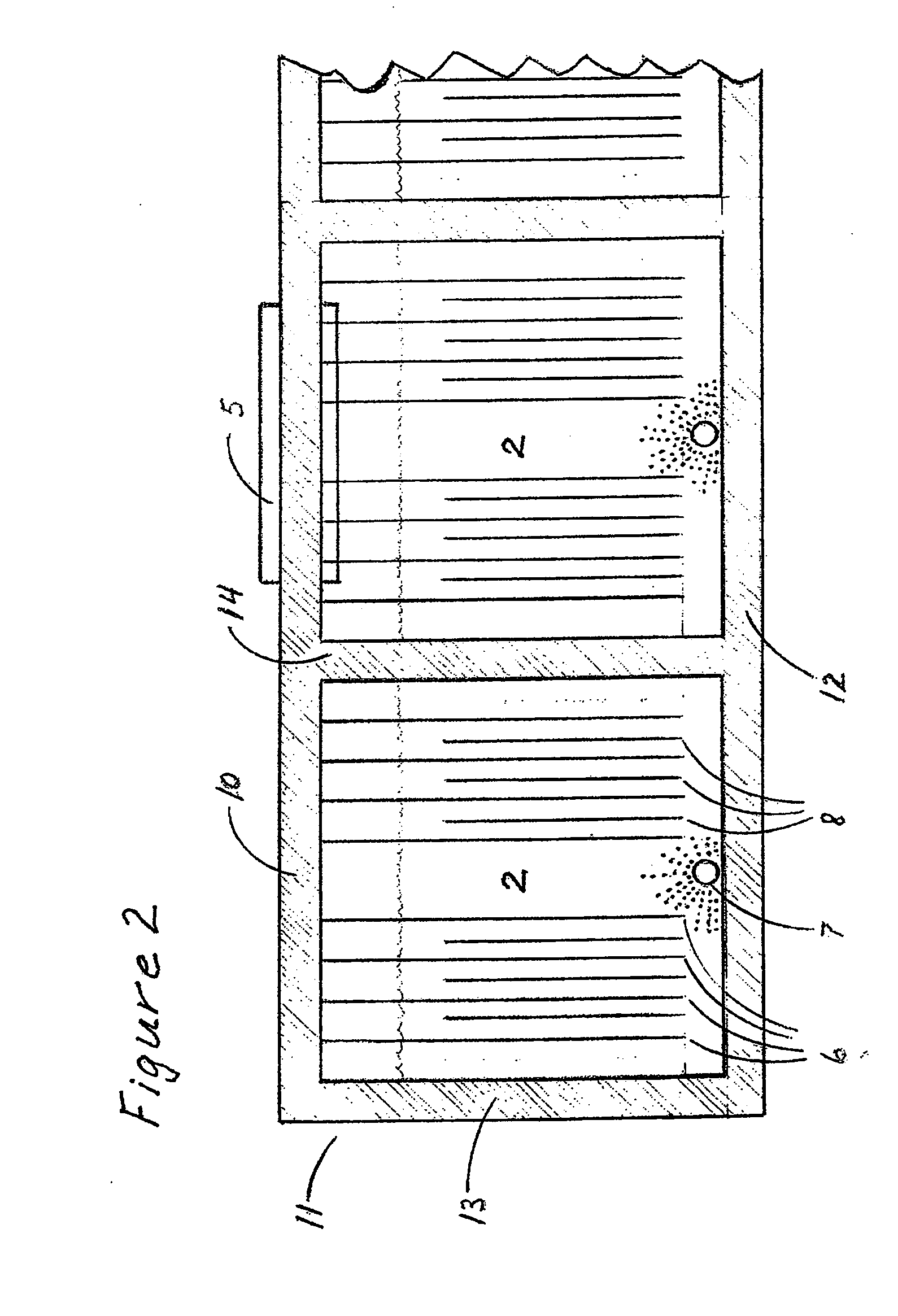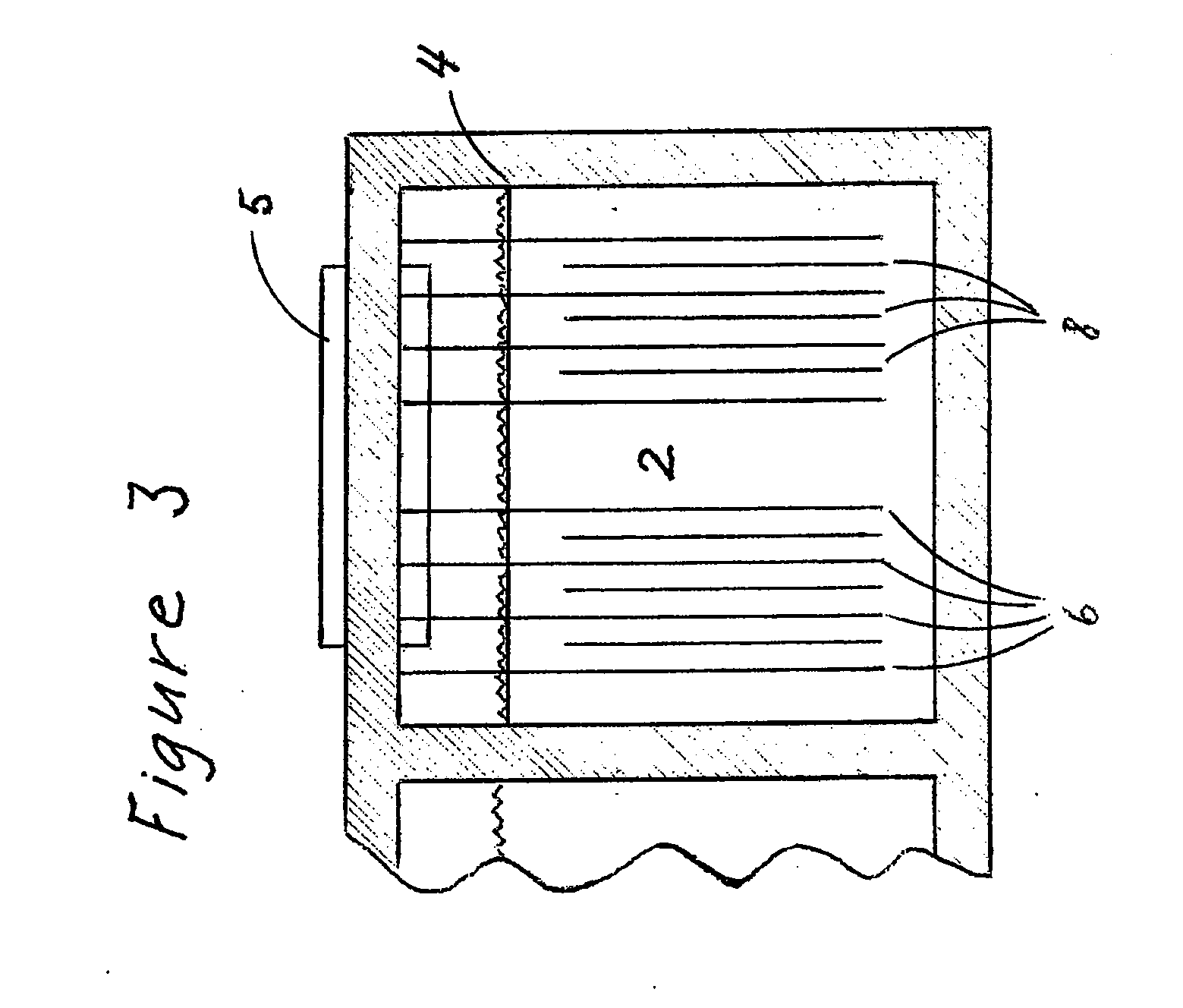[0016]The invention provides a process which uses large amounts of CO2 in
photosynthesis to grow
cyanobacteria microalgae in an enclosed, deep, slow-flowing water
system with optimally-balanced nutrients.
Artificial light is diffused throughout the
cell within which the flow of water is confined and can be continuously or intermittently supplied as discussed hereinafter.
Photocatalysis is present throughout to mineralize organic and inorganic compounds for absorption by the
algae and functions synergistically with the microalgae photosynthesis which produces
oxygen for use therein. Disinfection costs are reduced when the process is used for
tertiary wastewater treatment. Examples of waters to be treated include (1) activated
sewage sludge secondary treatment effluent of
municipal sewage plants, (2) solubilized farm animal excrement and
urine wastes, (3) industrial wastewaters and (4) salt and
brackish water.
Biomass growth is harvested and dried for fuel or other uses, and with sufficient
treatment time, the final
effluent is upgraded to
potable water. When disposal of CO2 is a primary objective, at least a major portion or all of the water is recycled. In all these processes, biomass growth is harvested and dried for fuel or other uses. In one particular aspect, there is provided a process for improving
water quality and growing microalgal biomass, which process comprises the steps of (a) providing at least one
cell which is generally closed to liquid flow by ceiling, floor and side walls except for a liquid entrance and an end wall overflow liquid exit, (b) providing partitioning walls in said
cell to create an extended flow path of at least about 500 feet total length from said entrance to said exit, (c)
coating the surfaces of vertical walls and ceiling with
photocatalytic coating material which, in the presence of light of the visible
light spectrum of about 400 to 700 nm, will effect mineralization of organic and inorganic compounds so as to provide resulting minerals that are available for absorption by the
metabolism of autotrophic
cyanobacteria microalgae, (d) supplying a
continuous flow of water to be treated to said entrance so that there will be a steady flow of water along the flow path at a velocity of at least about 0.023 feet / second, which flowing water contains autotrophic
cyanobacteria microalgae that require CO2 for growth and also contains nutrients to nourish the microalgae, (e) providing CO2 in the flowing water within said cell adequate for
microalgae growth, (f) distributing light which covers the visible
light spectrum into the flowing water along said flow path from floor to ceiling throughout the cell along the extended flow path, (g) providing ceiling service openings in the cell at spaced locations along said flow path and recovering offgases and harvesting microalgal biomass through said service openings, (h) maintaining the cell
water level at a predetermined depth to assure there is void head space between the water surface and said ceiling, and (i) removing water of improved
water quality from the cell.
[0018]In a further particular aspect, the invention provides a process for utilizing CO2 and growing microalgal biomass, which process comprises the steps of (a) providing at least one cell having a floor, a ceiling and side walls, which cell is generally closed to liquid flow except for a liquid entrance and a liquid exit, (b) providing partitioning walls in the cell to create an extended flow path of at least about 500 feet total length from the entrance to the exit, (c)
coating the vertical surfaces of the sidewalls and the ceiling surface with
photocatalytic coating material which, in the presence of light of the visible
light spectrum of about 400 to 700 nm, will effect mineralization of organic and inorganic compounds so as to provide resulting minerals that are available for absorption by the
metabolism of autotrophic cyanobacteria microalgae, (d) supplying a
continuous flow of water to the entrance so that there will be a steady flow of water along the flow path at a velocity of at least about 0.023 feet / second, which flowing water contains autotrophic cyanobacteria microalgae that require CO2 for growth and also contains nutrients to nourish the microalgae, (e) diffusing CO2 into the flowing water at multiple, spaced locations along the flow path within the cell adequate for
microalgae growth so as to maintain an average of at least about 1,000 ppm of CO2 within said flowing water, (f) distributing light which covers the visible light spectrum into the flowing water from about floor to ceiling throughout the cell along the extended flow path, (g) recovering offgases and harvesting microalgal biomass at spaced locations along said flow path, and (h) removing water through the exit and returning at least a major portion of the removed water to the entrance for another pass through the cell, whereby large quantities of CO2 can be efficiently utilized to generate useful biomass.
 Login to View More
Login to View More  Login to View More
Login to View More 


